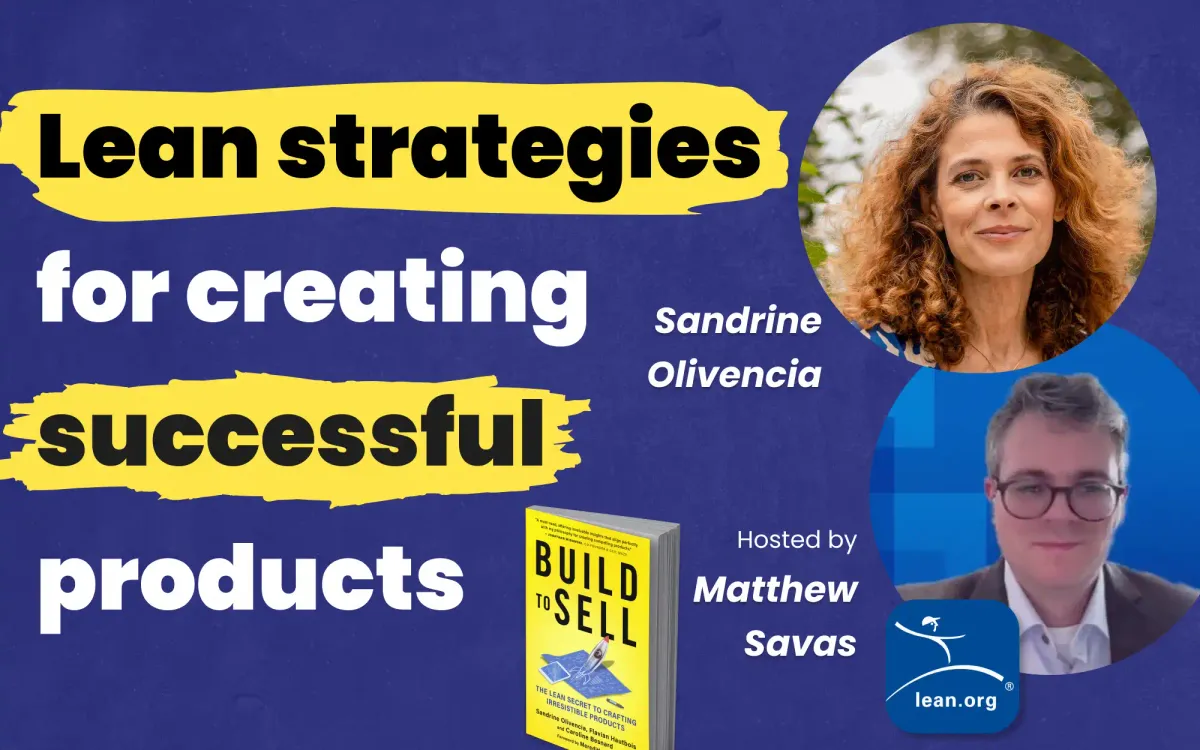Build to Sell: lean strategies for creating successful products
I recently spoke at a Lean Enterprise Institute webinar, where I shared insights on applying lean thinking to help tech companies scale sustainably.

I recently appeared in a webinar hosted by the Lean Enterprise Institute. You can watch the replay of the webinar titled Build to Sell: Lean Strategies for Creating Successful Products (you'll need to register to access the video).
In the webinar, I shared my insights into how lean thinking can be applied to tech companies to help them scale sustainably. Drawing from my experience and research, I highlighted the key challenges startups and scaleups face and the strategies we can adopt to overcome them. Here are the main takeaways:
Lean thinking in tech: all about the product
I have spent decades applying lean thinking in tech to help companies scale sustainably and profitably. During my annual visits to Japanese companies alongside startup and scaleup founders and CEOs, I realized a core truth: lean is fundamentally about the product. In the original lean organizations, everyone works towards delivering the most perfect version of the product. However, the engineering and design aspects are the least understood, which motivated me to write Build to Sell. I believe that integrating lean principles into modern tech product development is essential for sustainable growth and long-term success.
Why startups fail: missing the mark, high costs, and inefficiency
I identify three main reasons why 90% of startups fail within the first five years. The first challenge is failing to hit the mark with the product. Many startups struggle to find the right product-market fit and, when they miss, they often face the traumatic process of pivoting. Product design should aim to get it right on the first try, balancing precision with experimentation. The second reason for failure is that products are often too expensive to make. By applying design thinking not just to the core product but to the entire set of customer experiences, startups can reduce costs and create more value. Lastly, as startups grow, internal processes tend to become inefficient. I refer to this as the "iron law of scaleups," (which originated in the Lean Strategy) where companies shift focus from being product-obsessed to becoming bureaucracy-obsessed.
The role of the Chief Product Engineer
To overcome these challenges, I highlight the importance of the Chief Product Engineer—a role inspired by Toyota’s Chief Engineers. Unlike traditional product management roles, these leaders are responsible for the product’s success from A to Z, including its financial viability. Chief Product Engineers lead by influence, and display a deep passion for both the customer and the technology. They ensure that the product, developed by expert teams, maintains an overall cohesive vision.
Challenges of growth: a founder-led Chief Product Engineer organization
In the early stages, startup founders often are the initial Chief Product Engineers. However, as the company grows, founders begin to fully delegate management and design responsibilities. The founder’s role delegation, while essential for growth, often leads to a loss of the entrepreneurial drive that initially fueled the company’s early days. Developers focus on code, Product Owners manage user stories, and Product Managers prioritize roadmaps, creating silos that overly dilute the original passion for the customer. I argue that it’s possible to train and develop Chief Product Engineers within a growing organization, preserving that crucial customer-centric mindset. Build to Sell is written as a training guide to achieve just that.
Going to the gemba: understanding the customer experience
One of the key practices that Chief Product Engineers embrace is “going to the gemba”—a Japanese term meaning “the real place.” Going to the customer’s gemba involves immersing ourselves in the environments where our products are used to gain a concrete understanding of the customer’s needs and the gaps our product fills. The webinar highlights the Lean Enterprise Institute’s case study of the 2019 Honda Passport as a prime example of this approach. In software, I observe that product teams often rely on data, analysis, and replays instead of directly interacting with customers. This approach by proxy, while informative, misses the emotional connection necessary for creating truly impactful designs. By experiencing the customer’s world firsthand, Chief Product Engineers can better understand the emotions and circumstances that shape the product’s journey, from initial purchase to end-of-life—what I call the emotion-centric design approach.
Disrupting the market: the product takt
If you have a product takt and are constantly thinking about the next iteration, it’s a great way to maintain market leadership
Traditional market disruption often involves risky moonshots that require deep pockets. I offer a different approach, focusing instead on the concept of “product takt”—a regular, market-driven cadence that compels companies to reevaluate what value means, what new needs are emerging, and how to extend the product family. This takt forces companies to focus on making one impactful change at a time, countering the prevalent "feature-frenzy" syndrome, where product teams overload products with features in an attempt to revitalize them. If you have a product takt and are constantly thinking about the next iteration, it’s a great way to maintain market leadership. Your competitors will struggle to keep up, and even if they try to copy you, they will always be a step behind. This is how you end up disrupting an entire industry.
By focusing on design, cost, and customer immersion, companies can navigate the challenges of scaling while maintaining a clear and cohesive product vision. Build to Sell provides a roadmap for tech companies looking to instill these lean strategies and keep their product focus sharp as they grow.